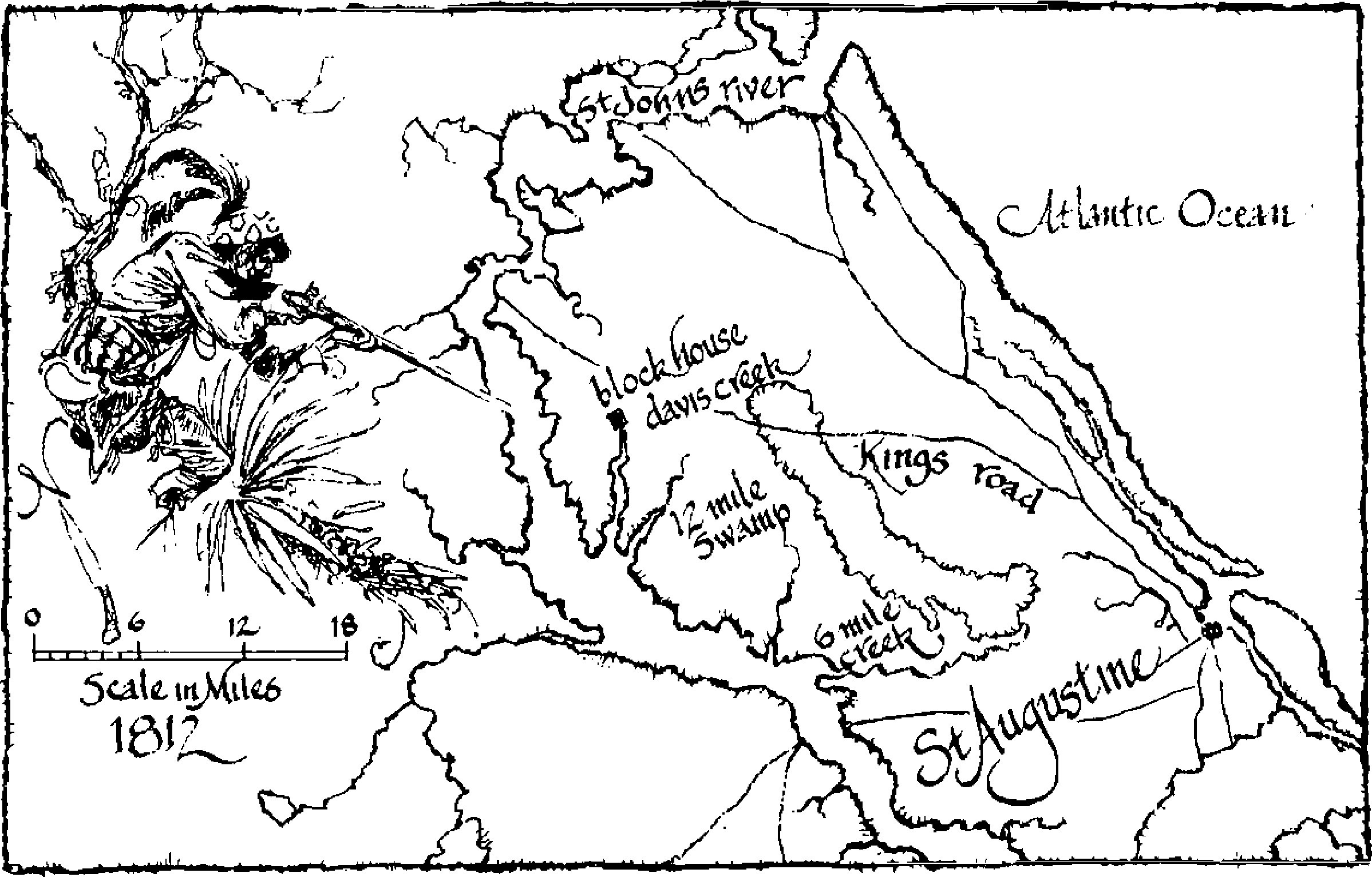
Twelve-Mile Swamp, named for its approximate distance from St. Augustine, Florida, is even now a forbidding area of cypress bogs and palmetto thickets. Through this heavily wooded wilderness on the evening of 11 September 1812, passed a ragged column of 20 Marines and Georgia militiamen, led by Marine Captain John Williams, a sensitive, 47-year-old Virginian. His mission was to escort a pair of supply wagons from the main camp of the Patriot Army near St. Augustine to the blockhouse on Davis Creek, about 22 miles to the northwest. Williams and his detachment had come to East Florida to join an expedition intent on annexing the Spanish province, out of fears that the British would use Florida as an advance base for an invasion, and that escaped slaves would inspire insurrection in the southern states.
The Marines, half-starved, ill with fever, their dress uniforms tattered from months of frustrating shore duty with the Army, were more than a little uneasy as they eyed the surrounding thickets. They were well aware that bands of armed Seminole Indians and runaway slaves were active in the area. Anxious to reach the safety of Davis Creek before sunset, they hurried the blue military supply wagons through the gloomy swamp as twilight deepened. Suddenly, the woods along the trail erupt with a blaze of musket fire as a large band of Indians and blacks fires a pointblank volley into the column. Williams, his sergeant, and the lead team of horses are downed by the first shots. The wounded captain is quickly assisted off the trail by one of his men. His uniform is that prescribed in the 1810 regulations-navy blue coat faced with red, buttoned and laced in front with a gold epaulet on the right shoulder and counterstrap on the left; white vest and pantaloons with a scarlet sash; black knee-high boots; and, at his side, a sword and cocked hat with cockade and plume.
Distinguishable in, their blue coats, white pantaloons, and high crowned hats, Williams' Marines took up defensive positions along the trail and returned fire with their standard-issue 1808 smoothbore, muzzle-loading flintlock muskets. The badly wounded Captain Williams watched as Captain Tomlinson Fort, his militia counterpart from Milledgeville, Georgia, took over command, exhorting the troops to continue the fight until the last cartridge. At length, he too was wounded and ordered a retreat further into the swamp. As the fighting ended, the enemy band destroyed one wagon and drove the other off with their own wounded inside.
During the night, part of the detachment made its way to the blockhouse, while Williams, too severely wounded to be moved, hid himself among the palmetto thickets. The next morning, a rescue force found the Marine captain—his left arm and right leg broken, and his right arm, left leg, and abdomen pierced by musket fire. Searching further, they found six more wounded in the brush, in addition to Williams' sergeant, stripped and scalped.
“You may expect,” Williams wrote to Lieutenant Colonel Commandant Franklin Wharton four days later, “that I am in a dreadful situation, tho' I yet hope I shall recover in a few months.” Despite being moved to the relative comfort of a nearby plantation house, Williams died on 29 September. The ambush in Twelve-Mile Swamp and Marine Captain John Williams' subsequent death proved to be the catalyst which brought an end to an ill-conceived and diplomatically embarrassing American scheme to annex Spanish East Florida by force.
Among the source materials used in the preparation of the painting and plate description were: sketches and photographs made by the artist on a visit to Twelve-Mile Swamp; Captain John Williams ltr to Lieutenant Colonel Commandant Franklin Wharton, dtd 15 Sep 1812 (Commandant's Letters Received, RG 127, National Archives, Washington, D.C.); J. H. Alexander, “The Ambush of Captain John Williams, U.S.M.C.: Failure of the East Florida Invasion, 1812-1813,” The Florida Historical Quarterly 56 (Jan1978), pp. 280-296.
